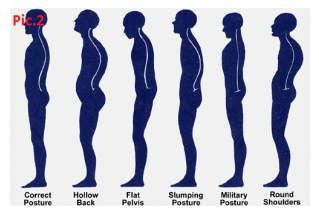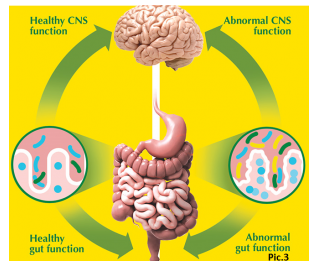How lower back pain occurs: what causes lower back pain in females??
- healthyorganic4u
- Feb 15, 2021
- 4 min read
Pain along the spine can have several causes. But the main and most common of them is muscle spasm.
In the thickness of the muscle there is a large number of small nerve endings and blood vessels, which can be irritated due to mechanical compression, which causes a feeling of pain, a feeling of "pinching" in the back. Pic.1

Evolutionarily, the tension of the back muscles has a protective character: protection of the elastic intervertebral disc from excessive stress, but in some cases this mechanism can harm.
If you, or someone you love, struggles with chronic, or even occasional back pain...This simple yet powerful stretch is helping erase years of back pain for those who have battled herniated disks, sciatica, and chronic back pain, some for decades.
You have got to see this video. It's based on the strange Himalayan secret to erasing back pain. Watch Now
The most common causes of muscle spasm that can cause back pain
1. Strong and / or prolonged mechanical impact , including static (long stay in one position, lifting weights).
2. A sedentary lifestyle. Any organ, including a muscle, is better filled with blood when it is fully functional. Reduced blood flow to a muscle makes it more prone to painful spasms.
3. Strong temperature impact or temperature or humidity drop.
4. Irregularities in posture : the spinal column is the shock-absorbing structure of our body. Unfortunately, for many people, this shock absorber has an irregular shape due to congenital features of the spine. In this case, the load along the back will be unevenly distributed and some muscle groups are overloaded. Pic.2

5. Violation of the internal organs. The liver, kidneys, pancreas, intestines can release into the blood an excessive amount of substances harmful to the body if they are in an unhealthy state. In
this case , both muscles and nerve endings become more sensitive to all negative influences.

6. Weakness of the intervertebral discs. The intervertebral disc is an elastic layer between the vertebrae that softens the mechanical stress on the spine. Due to congenital features or due to a lack of nutrients in the nutrition of many people, the intervertebral discs are more sensitive to stress, they can become inflamed, become thinner, and form hernias, which also leads to muscle spasm and back pain.
Important! In most cases, the intervertebral disc itself cannot be a source of pain, since it normally contains neither nerves nor blood vessels, and nutrients enter it by diffusion (soaking). Pic 4.

According to the scientific literature of the past five years , back pain with more serious causes than muscle spasm is rare. For example, infringement of the nerve root by disc herniation is observed in less than 10% of cases, but nevertheless, such a diagnosis is mistakenly made very often.
Cases of "prolapse" of intervertebral discs are completely casuistic , and such "diagnoses" often indicate a low qualification of the diagnostician or a desire to deliberately mislead the patient, cause a feeling of fear.
If the pain does not go away for a long time
If you ignore back pain for a long time or undergo unqualified treatment, then the pain can turn into a chronic phase.
The reason for this is the formation of myofascial trigger points and blocks in the thickness of the muscle. These are small local seals, due to which
1) the blood supply to the muscle worsens,
2) signals from these seals are constantly received in the brain and medulla oblongata, and after a certain time the brain begins to perceive them as chronic pain.
This pain is of low intensity but can last for years. Pic. 5.

Spine problems cause more than pain
Depending on the localization of the disease process, the body can react not only with pain .
A persistent increase in muscle tone and the accumulation of trigger points can lead to compression of the vessels that supply blood to the brain, irritation of the nerves responsible for the work of internal organs, including the work of the heart and the maintenance of blood pressure. These reactions are very individual and depend on the general condition of your body. Pic. 6.

1. With a problem in the cervical spine, the following are possible: dizziness, tinnitus, impaired hand sensitivity, fluctuations in blood pressure, snoring, persistent headache, migraine attacks, feeling of a lump in the throat.
2. In case of a problem in the thoracic spine, pain in the heart, respiratory failure, neurotic disorders, panic attacks are possible.
3. In case of a problem in the lumbar spine, numbness of the legs, pain in the joints, night cramps in the legs, disruption of the pelvic organs, hemorrhoids, and disturbance in the genital area are possible.
Important! Due to a violation of the normal state of the cervical spine, a decrease in blood flow to the brain can often be observed . The first signs in this case are often irritability, sleep disturbance, memory impairment, depressed mood, loss of motivation. That is why a healthy spine is the basis for a healthy brain . Pic.7.

A rational view of the problem
If you are faced with this low back pain problem, then you need to understand that your disease is not the result of some one-time negative impact, but arose due to long-term systematic age processes and your internal predisposition. The age of onset of the disease can be very different and sometimes you can face a problem even before thirty years.
Fortunately, you can get rid of the problem and keep it under control , and with the right approach, the percentage of positive results is much higher than with most other diseases.
According to the recommendations of the following organizations: American Academy of Family Physicians, American Academy of Neurology and European Academy of Neurology , the first methods for both acute pain and prevention should be non-drug methods of exposure, which include stretching manipulations on the spine, reflexology, acupuncture, procedures warming and increasing blood flow , independent exercises for stretching the muscles of the spine.
In some cases, chondroprotective therapy is recommended - the introduction into the body of substances necessary to maintain the normal state of the intervertebral disc.
Important! Back exercises should be carefully and individually selected under the guidance of a suitably qualified person. Improper selection of exercises can lead to an aggravation of the problem.










Comments